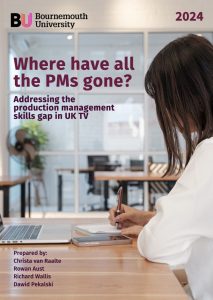 New research into production management in the UK’s TV industry has found that there is a corrosive cultural divide between ‘production’ and ‘editorial’. This distinction between those involved in the ‘creative’ aspects of making tv and those who manage its more logistical aspects is what lies at the heart of much of the discontent experienced by today’s production managers, the research has found.
New research into production management in the UK’s TV industry has found that there is a corrosive cultural divide between ‘production’ and ‘editorial’. This distinction between those involved in the ‘creative’ aspects of making tv and those who manage its more logistical aspects is what lies at the heart of much of the discontent experienced by today’s production managers, the research has found.
‘We have known for a long time that production managers lack visibility and feel undervalued’, explains Dr Christa van Raalte, who led the project. ‘When three-quarters of respondents told us last year that they were seriously considering leaving we knew the problem was deeply rooted. The aim of this latest research has been to gain a much clearer understanding of what it is that attracts people into production management roles in the first place and what we could do better to keep them. What’s the point of investing in the recruitment of new production talent if we can’t hang on to the ones we’ve got?’
The new report launched this week, Where have all the PMs gone? Addressing the production management skills gap in UK TV, builds on an earlier survey with in-depth interviews. The result is a detailed and nuanced account of the experience of working in production management. The report makes eleven recommendations for change, from clearer job definitions and more equitable pay rates, to improved training and development.
The report concludes that there is much to be done to ensure that production management is properly recognised and understood both in and beyond the industry, that PMs are treated equitably and respectfully, and that employers are able to recruit and retain the workforce they need. This cannot be achieved without addressing ingrained working culture and practices. The challenge this represents for the wider industry, claims the report, should not be underestimated.
The project’s research team is based at the University’s Centre for Excellence in Media Practice (CEMP) and funded by the British Academy and Leverhulme Trust.
The full report and a shorter summary are available at https://eprints.bournemouth.ac.uk/39530/
Tagged / TV
We need policy and evidence to help change TV work culture
 This week we submitted written evidence to the Culture, Media and Sport (CMS) Committee. This is the Parliamentary Select Committee that scrutinises the work of the Government Department (DCMS) that has recently launched an inquiry into ‘What the industry and Government can do to ensure British film and high-end television adapt for the future’. The area they have chosen to look at is a broad one, but the evidence we have submitted directly addresses two specific subsidiary questions: First, what should be prioritised to ensure a strong skills pipeline and retention in the film and high-end television industry? And second, what needs to change to ensure the industry is supporting inclusivity and sustainability?
This week we submitted written evidence to the Culture, Media and Sport (CMS) Committee. This is the Parliamentary Select Committee that scrutinises the work of the Government Department (DCMS) that has recently launched an inquiry into ‘What the industry and Government can do to ensure British film and high-end television adapt for the future’. The area they have chosen to look at is a broad one, but the evidence we have submitted directly addresses two specific subsidiary questions: First, what should be prioritised to ensure a strong skills pipeline and retention in the film and high-end television industry? And second, what needs to change to ensure the industry is supporting inclusivity and sustainability?
These questions relate directly to the research that we do here at BU in the Faculty of Media and Communication into the nature of work in the media industries: project-based and heavily dependent on a largely freelance arms-length workforce. Its prevalent employment model, the ‘bulimic’ (feast-or-famine) flow of work and its short-term but highly intensive character present many challenges, both to the individual and the employer. Work in TV often involves poor hiring practices, it militates against inclusivity and sustainability and can involve high levels of stress that creates a culture susceptible to bullying and harassment.
Depressingly – and as if on cue – just as we were marshalling our evidence for the CMS Committee, the story broke of yet another high-profile example of the sort of bad behaviour that often goes unchecked in this kind of work environment. Our piece in The Conversation published today frames the Russell Brand case in the context of the underlying – systemic – problems that we want to help the CMS Committee to understand.
Read our article in full: Russell Brand allegations are leading to renewed scrutiny of the endemic bullying and harassment in the TV industry. The Conversation, September 21, 2023
Finding answers to the problem of workplace bullying in Film & TV
 18-months ago we published a major study of the UK’s unscripted TV labour market. We found that a staggering 93% of professionals in this sector had experienced or witnessed bullying or harassment at work. An industry defined by highly sought-after creative work had a shadow side. The picture to emerge was one of a troubled workplace in pressing need of reform. Our report made six recommendations that had implications for both government policy and structural change within the industry.
18-months ago we published a major study of the UK’s unscripted TV labour market. We found that a staggering 93% of professionals in this sector had experienced or witnessed bullying or harassment at work. An industry defined by highly sought-after creative work had a shadow side. The picture to emerge was one of a troubled workplace in pressing need of reform. Our report made six recommendations that had implications for both government policy and structural change within the industry.
As the issue of bullying in TV has become more widely acknowledged, we have welcomed a number of recent industry initiatives and interventions introduced to deter it (including a campaign to encourage the reporting of bad behaviour and a free Bullying Advice Service). Yet despite these positive developments, not enough attention has been given to the underlying factors that contribute to workplace bullying. There remains an assumption that this is simply a problem of ‘a few bad apples’, when – in reality – it is the condition in which apples are kept that largely determines the damage caused by a bad one.
In our latest publication we examine this issue in more depth. We argue that it is the nature of television work, its organisational structures and the culture of the industry that creates a set of conditions that makes bullying particularly likely. Many of the characteristics shown by our study to be commonplace in television work, are precisely those identified in the field of organisational psychology as risk factors for workplace bullying. This being the case, we call for a risk management approach to this problem; one that systematically recognises, appraises and minimises these risks.
Christa van Raalte, Richard Wallis & Dawid Pekalski (2023) More than just a few ‘bad apples’: the need for a risk management approach to the problem of workplace bullying in the UK’s television industry, Creative Industries Journal, DOI: 10.1080/17510694.2023.2182101
Declining sport viewership shows why we should keep it on free TV
Heath McDonald, Swinburne University of Technology and Daniel Lock, Bournemouth University
This article was originally published on The Conversation. Read the original article.
If you’d like to pitch your own article idea to The Conversation, please contact either newsdesk@bournemouth.ac.uk or rbowen@bournemouth.ac.uk.
Declining television viewership for sporting events might suggest that those of us who heralded sport as a potential saviour of traditional broadcast media had it all wrong.
In Australia, ratings for the recent one-day cricket matches were dire and the Australian Open tennis was mixed. In the UK, viewership for the British Open golf collapsed by 75% and even the once untouchable English Premier League (EPL) has seen declines in certain timeslots. Meanwhile, Formula 1 is in a slow decline that has been ongoing for almost a decade, and the NFL is down year over year as well.
But putting the numbers under closer inspection reveals other explanations. Many of these leagues are moving onto pay TV or are the victims of changing sporting tastes. Rather than dampening broadcaster enthusiasm for live sport, they show why sport should remain on free TV.
A closer look at the numbers
The Australian Open television ratings are maybe the most interesting of the bunch. The women’s final won the night in Australia, but with fewer viewers than previous years. The men’s final was a huge drawcard and viewing figures were well up from the previous year’s final. Worldwide, however, both the men’s and women’s finals were significantly up on previous years.
So, what happened to Australian tennis viewership when the women’s final was on? More sport! The women’s tennis final was up against the final of the Big Bash League (BBL) cricket, which attracted more than a million viewers to come a close second in the ratings.
The increased popularity of the BBL shows fans aren’t cutting out or cutting down sport consumption. Instead, they are substituting one format of cricket, or one sport, for another. Cricket Australia launched the BBL for this exact reason, and it has been a tremendous success.
As BBL shows, the decline in one sport can be driven by consumer sport preferences changing, rather than people abandoning sport altogether.
The EPL and Champions Leagues, previously bastions of strong viewership, have also experienced fluctuations in audience figures. That said, a closer look implies that a lack of marquee fixtures in the EPL and the qualification of historically smaller clubs (i.e., Leicester) have diminished audience interest to some extent.
Moving to pay TV
Another explanation for declining audience figures concerns sports that have moved from free-to-air broadcasters to pay television. In the UK, the transition of the British Open from the BBC to Sky television led to a 75% drop in viewing figures. The highlights package broadcast on the BBC following the conclusion of the event drew almost half a million more viewers than the live coverage on Sky. This suggests that short-run events (at least in the initial stages of the relationship), such as the Open might be insufficient to translate British Golf fans into Sky subscribers.
In Australia, Optus gained the rights to EPL by paying almost three times the amount Foxtel was paying to show it previously. This has been the subject of a large amount of fan anger ever since. Viewership through these channels is difficult to track, but Optus subscriptions do not appeared to have increased markedly since the deal. Meanwhile, ratings for the home-grown A-league, which airs on Fox Sports and SBS, are up, possibly because fans are switching from EPL for their soccer fix.
But the money being offered to move to pay TV is hard to turn down.
It looks like the next five year BBL rights could go for up to $A300 million – a three-fold increase from the A$100 million Ten paid for the initial five year deal. A big part of the BBL’s success has come from it being broadcast every night of the week, on a major free-to-air channel, at a relatively non-competitive time of year. Broadcast it on pay TV and things might change. Sure, some people will subscribe, but BBL is largely a family sport and the added subscription costs could price out a substantial proportion of the consumer market.
Still a golden opportunity for free TV
Restricted broadcast threatens the future of a sport league. All brands grow by increasing the number of people who consume them. Only free TV gives that to sports brands. The EPL story defies this logic, demonstrating exponential growth since its transition to Sky Sports in the early 90s; however, if brands choose to limit distribution to narrow channels like pay TV, the chances of brand growth are severely limited.
Advertisers and sponsors, already confused about where they should be advertising, are also big losers if sport isn’t shown on free-to-air TV. As Professor Mark Ritson explains quite colourfully, traditional media gets much better results than social media advertising and other alternatives. But to do so, it must have wide reach – it needs to be attracting large audiences. If free to air television was to lose big draw card sport broadcasts, audiences shrink and advertising there becomes much less powerful.
Whatever it costs to retain sports on FTV, it is probably worth it for both advertisers and broadcasters. And it’s not just the sports that are big right now that they should focus on. Australia’s appetite for sport is not diminishing, but it is reshaping.
A recent survey we conducted of 4,000 people Australia-wide showed that interest in the AFL women’s league (AFLW) is strong. Around two thirds of AFL fans will either watch or attend at least one game of AFLW during this upcoming season. Across all people surveyed, around 27% said they were likely to attend a game of AFLW and 38% intended to watch at least half a match on television. Even allowing for the usual difference between what people intend to do and what actually ends up happening, these numbers are strong. The AFL has wisely moved games to bigger venues in anticipation of much larger crowds than the initial 5,000 per match estimates.
AFLW stands a very good chance of being Australia’s dominant women’s sporting league – in its very first year. For a savvy broadcaster, this represents a golden opportunity.
![]() Heath McDonald, Professor of Marketing, Swinburne University of Technology and Daniel Lock, Senior Lecturer in Sport, Bournemouth University
Heath McDonald, Professor of Marketing, Swinburne University of Technology and Daniel Lock, Senior Lecturer in Sport, Bournemouth University
TV, Film and Photoshoot Networking Event

When: Wednesday 21 September 2016
Time: 6.00pm – 9.00pm
Where: Aruba Beach Restaurant – Pier Approach, Bournemouth, BH2 5AA
Book your tickets here.
About:
Dorset Film Office aims to support, develop and build a strong creative community. Don’t miss out on ethe Dorset Film Office launch.
- Need to find out about more opportunities?
- Want to find more work in your local area?
- Looking to increase lead generation?
- Looking to raise brand awareness?
- Looking to grow your network and forge new relationships?
- Want to create strategic alliances?
Click here fore more information or phone 01202 980000
Book your free ticket to secure your place: Dorset Film Office Launch
Creative England – latest funding opportuntites
Please note that some funding bodies specify a time for submission as well as a date. Please confirm this with your RKEO Funding Development Officer
You can set up your own personalised alerts on Research Professional. If you need help setting these up, just ask your School’s/Faculty’s Funding Development Officer in RKEO or view the recent blog post here.
If thinking of applying, why not add notification of your interest on Research Professional’s record of the bid so that BU colleagues can see your intention to bid and contact you to collaborate.











 Dr. Chloe Casey on Sky News
Dr. Chloe Casey on Sky News Final Bournemouth University publication of 2025
Final Bournemouth University publication of 2025 On Christmas Day in the Morning…
On Christmas Day in the Morning… New Nepal scoping review on maternal & neonatal health
New Nepal scoping review on maternal & neonatal health ECR Funding Open Call: Research Culture & Community Grant – Application Deadline Friday 12 December
ECR Funding Open Call: Research Culture & Community Grant – Application Deadline Friday 12 December MSCA Postdoctoral Fellowships 2025 Call
MSCA Postdoctoral Fellowships 2025 Call ERC Advanced Grant 2025 Webinar
ERC Advanced Grant 2025 Webinar Horizon Europe Work Programme 2025 Published
Horizon Europe Work Programme 2025 Published Horizon Europe 2025 Work Programme pre-Published
Horizon Europe 2025 Work Programme pre-Published Update on UKRO services
Update on UKRO services European research project exploring use of ‘virtual twins’ to better manage metabolic associated fatty liver disease
European research project exploring use of ‘virtual twins’ to better manage metabolic associated fatty liver disease